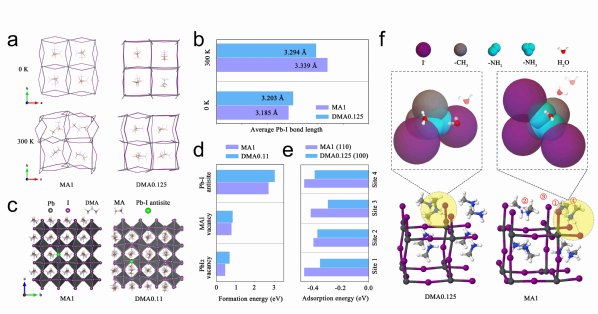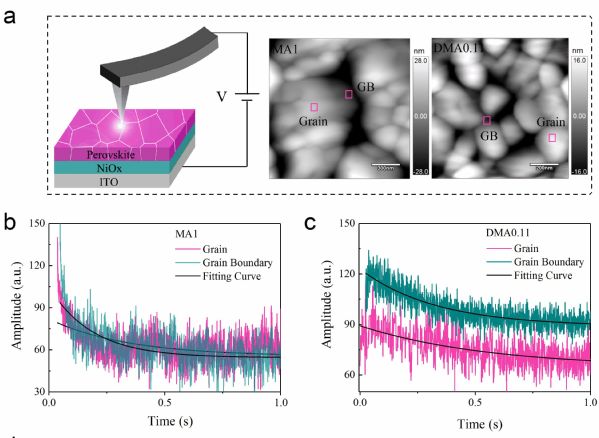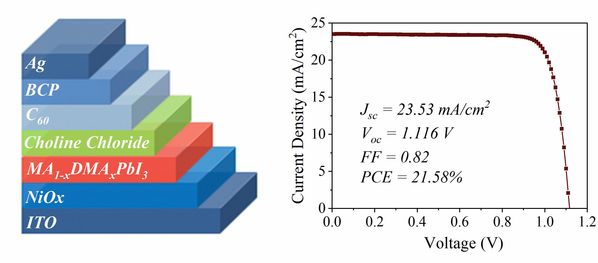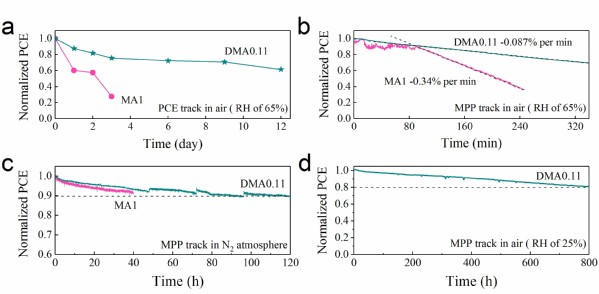Halide perovskite shows great potential as the most promising next generation of high-efficiency and low-cost solar cells. Currently, the main problem for the perovskite solar cell is the incompatibility of high stability and high efficiency. For example, the stability of inverted structure perovskite solar cells is good, but the efficiency is low, especially for the NiOx-based inverted structure perovskite solar cells with 19.2% as the highest certificated efficiency. How to simultaneously improve the efficiency and stability remains a great challenge.
With the support of National Key Research Program, Assistant Professor Ning Zhijun and collaborators have gained great progress in high stability and high efficiency perovskite solar cells by introducing the secondary amine into perovskite structure: the certificated efficiency of NiOx-based inverted structure perovskite solar cells up to 20.8%, and the device maintains over 80% of its original efficiency after 800 hours operational under continuous light illumination. Recently, their research findings were published in Advanced Materials in the article “Efficient and Stable Inverted Perovskite Solar Cells Incorporating Secondary Amines,” and was selected as a cover image.
The crystal structure of perovskite influences the stability greatly. For normal MAPbI3 perovskite, MA molecules are too small to fill the void of PbI6 octahedron, resulting in structural distortion. Hence MAPbI3 normally has tetragonal phase at the room temperature. Assistant Professors Mi Qixi and Ning Zhijun reported an effective method to increase the filling rate of organic molecule by introducing large size molecules, generated cubic phase structure with improved stability (Adv. Mater., 2017, 29, 1701656).
In recent work, researches improved the performance of inverted perovskite solar cells by adding dimethylamine molecule. The DFT calculation indicates that the dimethylamine molecule increased the rigidity of crystal structure. Electrochemical strain microscopy (ESM) characterization indicates the introduction of dimethylamine molecule reducing the ion’s transfer rate, which matches well with the calculated results.
Researchers then investigated the impact of structure rigidity on the defects formation. The DFT results demonstrate that the introduction of dimethylamine molecule increased the formation energy of defects, which contributes to the good stability of perovskite. They reported the 21.6% in lab and certified efficiency of 20.8%, which is the highest reported certified efficiency for the NiOx-based inverted perovskite solar cells, and the encapsulated devices maintain over 80% of their efficiency following 800 hours of operation at the maximum power point. This work verified that the structure rigidity has great effect on the performance of perovskite solar cells, which provide an effective method for the development of high efficiency and high stability perovskite solar cells.
PhD students Chen Hao and Wei Qi from Dr. Ning’s group performed most experimental and simulation work respectively. Professor Edward H. Sargent from University of Toronto, Professor Li Jiangyu from Shenzhen Institutes of Advanced Technology, Chinese Academy of Sciences, Assistant Professors Ke Youqi and Mi Qixi from ShanghaiTech University, Professor Long Run from Beijing Normal University contribute to the finish of this work. Liu Zhuojia helped the graphic design and fabrication. The Instrument Analysis Center and Electron Microscope Center of ShanghaiTech University provided great help of the materials’ characterization. This work was supported by the National Key Research Program, National Science Fund of China, start-up funding from ShanghaiTech University, and CℏEM, SPST, ShanghaiTech.

Figure 1. DFT calculation of perovskite structure. (a-b) Comparison of perovskite structure at different temperature. (c-d) Defects calculation. (e-f) The investigation of absorption energy of water.

Figure 2. Investigation of ion diffusion in perovskite films. (a) The graphic illustration of electrochemical strain microscopy (ESM). (b-c) The experimental ESM amplitude of grain (a) and grain boundary (b) versus time for MA1 and DMA0.11 measured on ITO/NiOx/perovskite under −2 V bias, the time of the x-axis is a reference time.

Figure 3. Structure and performance of devices. The perovskite solar cells structure is:ITO/NiOx/MA1-x DMAxPbI3/Choline Chloride/C60/BCP/Ag. The highest efficiency is 21.58%.

Figure 4. Stability of perovskite solar cells. (a) The stability of unencapsulated devices at 65% humidity condition. (b) Operation of unencapsulated devices under MPP conditions with a 420 nm cutoff UV filter in ambient air (relative humidity of 65%). (c) Operation of unencapsulated devices under MPP conditions without UV filter in N2 atmosphere. (d) MPP tracking of encapsulated device under continuous LED light illumination at 20 ºC and 25% humidity condition.

